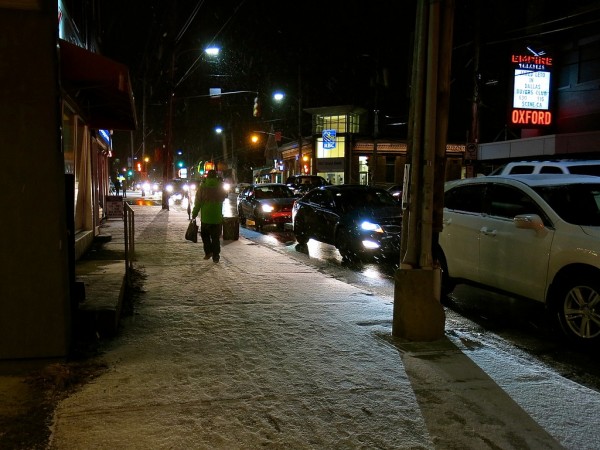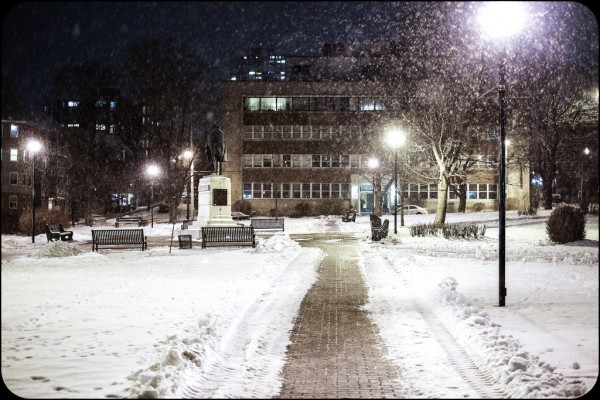HALIFAX – With all the broken wrists, slips, and copious amounts of ice and snow remaining on city side sidewalks after recent snowstorms, HRM’s revised snow-removal plan for side streets is under fire.
Previously, HRM was responsible for sidewalks in most HRM districts through an area rate while property owners on the peninsula, Armdale, and Spryfield, were responsible for the sidewalks in front of their houses. (The City of Halifax has had this policy on the books previous to amalgamation.) Councillor Linda Mosher successfully rallied support (if narrowly) earlier this year to extend municipal clearing to all of HRM.

A Maclean’s editorial from 2011 made a passionate case for city sidewalk snow clearance as a basic municipal service. It’s a worthy read that skims across several different Canadian cities citing overall financial savings, city/municipal liabilities, and that sidewalks are as important as road clearance that we already all pay for:
“Sidewalks are a fundamental element of the urban transportation infrastructure,” says Barry Wellar, professor emeritus of geography at the University of Ottawa and creator of a walkability index for Canadian cities. “It is bizarre that any city would fail to provide the same level of service for sidewalks that it does for roads. This makes its pedestrians second-class citizens.”
While most cities do not suffer the freeze-thaw cycle like HRM, Ottawa’s service standards seem positioned to ensure that the tax-paying citizen that chooses to walk in its urban core will find their route as clear as another citizen that chooses to drive. Higher levels of service for higher levels of usage would make sense, right?
At issue is whether HRM’s 36-hour turnaround on sidewalk snow clearance for the peninsula, its densest populated area, is adequate or not. So far, it is clearly not.
In an urban core where more than 50% choose to walk as their primary mode of travel, the speed and quality of that snow removal is imperative. But if other cities have figured this out, how can we do it better? Or is it the city’s responsibility at all? And how could or should we expect better servicing in HRM’s urban core?
While a couple bad storms might be an aberration, the sidewalk clearance service warrants consultations and a second look by HRM Council.
What are your thoughts?
Here’s a look at service standards for the major cities in Atlantic Canada. Click the blue links to be directed to the city’s or municipality’s snow clearance webpage.
- P1: Main Arterial Sidewalks, cleared within 12 hours following end of snowfall.
- P2: Transit Sidewalks, cleared within 18 hours following end of snowfall.
- P3: Local Sidewalks, cleared within 36 hours from end of snowfall.
- Plow all sidewalks in the central business district and main arteries within 24 hours of storm end.
- Plow all remaining sidewalks identified on the Sidewalk Snow Clearing Plan within five working days from the end of the storm.
Note: Snow removal for sidewalks is determined along with street clearance. Priorities listed below are for both streets and sidewalks. The densely populated areas are Uptown and South End Peninsula where snow clearance varies between Priority 1 and 4 (48-96 hours.) See Winter Management Plan map here.
- Priority 1 plow routes include arterial streets, highway connections and emergency routes (165.2 km). Within 8 hours of the end of a storm, they have bare pavement on the travel lanes. Two days after a storm, they have bare pavement, curb to curb.
- Priority 2 plow routes include major bus routes, schools, community centres, business districts (92.7 km). Within 8 hours after the end of a storm, they have bare pavement on the centre line (the main travel area on the street). Two days after a storm, they have bare pavement on the travel lanes.
- Priority 3 plow routes include collector streets, minor bus routes, industrial parks (127.7 km). Within 12 hours of the end of a storm, they have bare pavement on the centre line. Within three days after the storm, they have bare pavement on the travel lanes.
- Priority 4 plow routes include local or subdivision streets (286.2 km). Within 12 hours of the end of a storm, they’re accessible and could be snow packed. Within four days after a storm, they have bare pavement on the centre line.
Fredericton service standards
No online source for clearance standards that we could find. Waiting on word from city officials.
- Sidewalk snow plowing starts after pushback of streets is completed. Depending on the amount of snow on the ground and equipment availability the majority of streets in the sidewalk program will be plowed within four to seven days. The time to complete this will increase if a new storm occurs during this time frame.
Note: service standards for storms up to 25 cms have an initial cut response standard of within 12 hours following end of storm, while larger storms have an interminate time for initial cut.
Photos by louisjacob and the Ikebana Shop
Abad is the Editor for Spacing Atlantic. Contact him on Twitter @AbadKhanNS or by email at fullname @ spacing.ca


One comment
The majority of streets in the St. John’s sidewalk program are chosen for their heavy foot traffic. By the time they’re cleared days after a snowfall, most of them have an icy layer of compacted snow that is impossible to remove with a plow or snowblower. The city uses salt so sparingly that bare concrete isn’t seen again until spring. Clearing sidewalks properly is possible in St. John’s, as shown on the MUN campus, but the city needs to treat pedestrians with the same respect accorded to motorists.